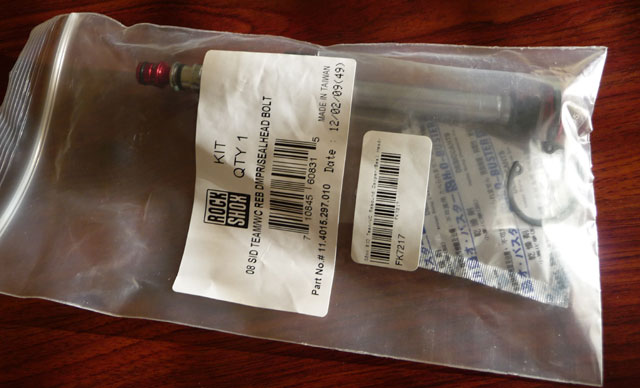SID Race rebound damper
The 2009/2010/(2011?) SID Race forks feature a port orifice rebound damper. You can see one of the 2 orifices in this close-up. It is the round hole in the rod just above rebound check-valve spring which closes on rebound to force the damping oil through the rebound port orifice (note: there is a very slight gap in the sealing surface of the check valve that provides a minimal free-bleed for the rebound circuit, but the great majority of the oil on rebound must go through the orifice. The purpose of this slight gap may be to act as a start point to reduce the surface tension that holds plates against other flat surfaces and can cause initial harshness in suspension systems). Inside the orifice is where the rebound adjustment rod screws up and down to allow more or less oil to flow through the rebound circuit.
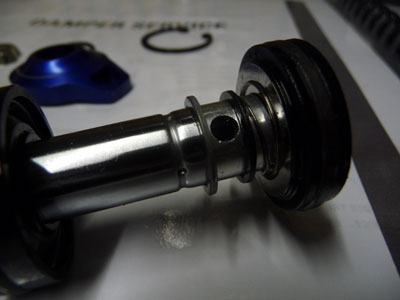
Here is the view of the rebound end of the damper. The other end features a spring activated check-valve to force the damping oil on rebound through the rebound port orifice.
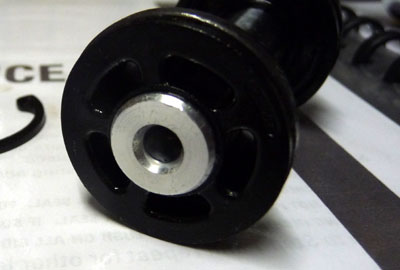
SID Team, World Cup and XX rebound damper
The 2009/2010/(2011?) SID Team, World Cup and XX forks feature a shimmed rebound damper:
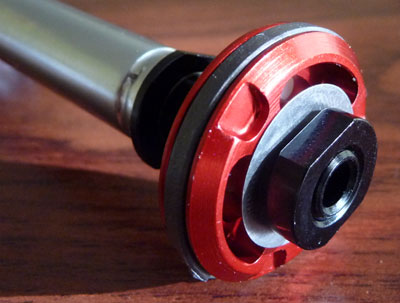
The Rockshox part number is 11.4015.297.010. I got this one from Universal Cycles for $68.

Doing the upgrade
You can do this upgrade in under 15 minutes if you don't need to service your fork. If you haven't serviced the fork in a while then I'd do a service instead of the 15 minute method below.
Step 1 - flip the bike
Let the air out of the positive and negative springs. Flip your bike over and undo the negative air spring retaining nut and the rebound rod bolt. Just before the negative air spring retaining nut comes off the air valve, give it a tap using the socket to unseat the air valve.
Step 2 - pull off the lowers
Pull off the lowers. When you do this the lubricating oil in fork outers will run out and down the stanchions. Put a rag on the fork crown to catch this oil. Letting this oil run down the stanchions will wash away any dirt you have on the stanchions. Wipe the stanchions down from the top towards the crown, but not back up to keep the internals as clean as possible.
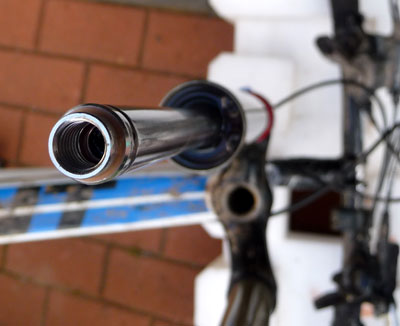
Step 3 - remove rebound rod
Remove the rebound rod by first taking the retaining circlip off using circlip pliers. With the circlip off slide the rebound rod off the end of the fork leg. Before completely withdrawing it, let any damping fluid on the rebound piston run back into the damping chamber. If you are careful and don't spill the oil out of the damping leg you will not need to refill and measure the oil levels. If you do loose any real quantity of oil doing this procedure then you will need to remove the motion control damper, drain all the oil and refill with 93ml of 5wt.
Step 4 - fit the new rebound rod
Make sure you give the new rebound rod a liberal coating with 5wt fork oil and reassemble it into the stanchion. Remember to fit the retaining circlip.
Step 5 - refit the fork lowers
Now flip you bike up so that the fork stanchions are parallel with the ground. Squirt 5ml of 10wt fork oil into each side of the fork lowers and hold them on a slight angle so the oil stays within the lowers. Slid them back on the fork and refit the air spring retaining nut and the rebound rod retaining bolt.
Step 6 - air it up
Air the fork back up and you're done.
SID Team, World Cup and XX rebound damper - some thoughts
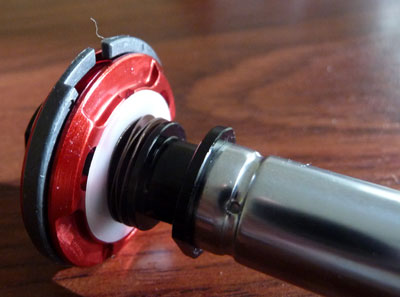
There's no doubt the Team/World Cup/XX rebound damper is vastly superior in design to the SID Race port orifice damper.
BUT, the single small stiff shim (I stupidly didn't measure it before I installed it, but it is around 16mm in diameter and 0.2mm thick) seems fairly primitive in itself as far as rebound shim stacks are concerned. The nut (clamp) that holds the shim in place also looks like it will come into play as an even larger clamp if/when the shim experiences larger deflections. Perhaps the rebound speed is never sufficient to result in that amount of deflection?
Normally on the end of a damping rod like this we'd see the rebound stack and on the other side the compression stack (or in cartridge forks the mid-valve or check plate). On the Rockshox motion control / black box type forks (like the SIDs, REBA, Pike, Pilot) there is nothing that results in oil being forced into the Moco unit except the oil volume displaced by the rebound shaft. The ports in the rebound shaft in the compression direction seem so large its hard to imagine much of a pressure build-up caused by the seal head, so this leaves the volume taken up by the rebound rod as the main pressure driver on compression.
